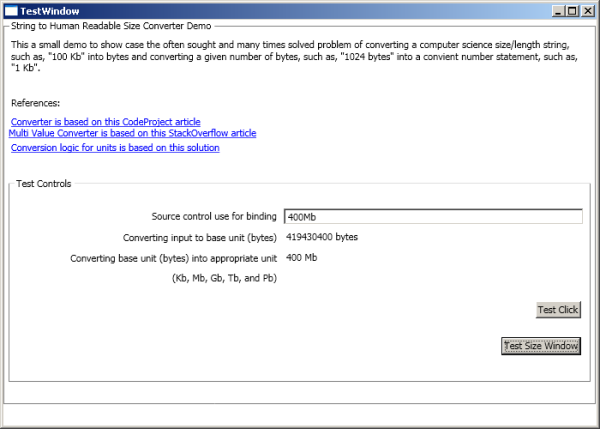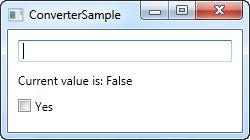Value Converters In Wpf
The value converter not only designed to take input from the target and modify the source it also works when source data is updated on target. When source object type and target object type are different at that time value converts are used to manipulate data between source and target.
Mitesh Sureja S Blog Multi Value Converters In Wpf
See the following XAML code example.
Value converters in wpf. Technically value converter is a class that implements IValueConverter. Example of Value Converter in WPF To define a value converter you just need to implement the interface IValueConverter and use it while data binding. Converter class must implement IValueConverter interface.
As you are familiar with two way bindings in WPF. WPF on using a markup extension to make it cleaner inline here. Value Converters in WPF Value converters are used in Data binding.
The WPF converters acts as a bridge between the source and the target if the source and target have different data formats or need some conversion. Make it public and implement the IValueConverter interface. This is a common naming for value converters.
After declaring the resource it is necessary to use it with binding. The following example shows the implementation of a date converter that converts the date value passed in so that it only shows the year the month and the day. With value converters you can also localize data create object based on underlying data and even create objects and.
List IValueConverter public object Convert object value Type targetType object parameter CultureInfo culture return thisAggregate value current converter converterConvert current targetType parameter culture. To do this add a class to your project and call it SourceTypeTo TargetTypeConverter. They dont need any state from the current binding instance I use static converters ie.
To convert data during binding you must create a class that implements the IValueConverter interface which includes the Convert and ConvertBack methods. In the previous article in the WPF tutorial series we started to look at value converters and their use in data binding. Value converters are used in Data binding.
IValueConverter has two methods. When source object type and target object type are different at that time value converts are used to manipulate data between source and target. Often we need to change certain values to be displayed on to.
To use a converter you need to implement the interface of the converter class in the XAML page of WPF you need to declare the resource. Hi Guys Let us learn a simple and very effective concept concept in WPF ie. If you want to use data binding in WPF with incompatible types you need a value converter which is a piece of code that converts the source type to target type and back.
There is a Employee class which we will be data binding to the UI. In the case of singleton-type IValueConverter s eg. Value converters are used to display values in a more meaningful manner in WPF.
To implement Value Converters there is the requirement to inherit from IValueConverter in the SystemWindowsData namespace and implement the two methods Convert and ConvertBack. In WPF Binding helps to flow the data between the two WPF objects. Converter xStatic SomeNamespaceSomeConverterInstance Theres also a great post by Dr.
A value converter allows a target property to be bound to a source of a different and incompatible type. This converter will chain multiple converters together. For example sometimes we need to convert data from one format to another format when it flows from the source to the target or vice-versa the conversion is required.
WPF already provides a few value converts but you will soon need to implement your own converts. The IValueConverter interface consists of two methods Convert and ConvertBack. Value converters are basically used with data bindings.
Public class ValueConverterGroup. Public object Convertobject value Type targetTypeobject parameter CultureInfo culture public. Converter class must implement IValueConverter interface.
We will straight away create a WPF Application and.

Implementing Value Converters With Ivalueconverter For Xamarin Forms
Piping Value Converters In Wpf Codeproject

Value Converters In Wpf Youtube

A Universal Value Converter For Wpf Codeproject

Value Converter 2 000 Things You Should Know About Wpf

Custom Value Conversion In Wpf Codeproject

Xaml Value Converter With A Simple Example

Using Valueconverter And Multivalueconverter In Wpf Codeproject

Wpf Winforms Charts Spectrogram Chart Visualisation Power

Value Conversion With Ivalueconverter The Complete Wpf Tutorial

Mailbee Net Objects V12 1 Retailmailbee Net Objects Bundle Includes Smtp Pop3 Imap Security Antispam Outlook Convert Microsoft Visual Studio Pop3 Antispam









Post a Comment for "Value Converters In Wpf"